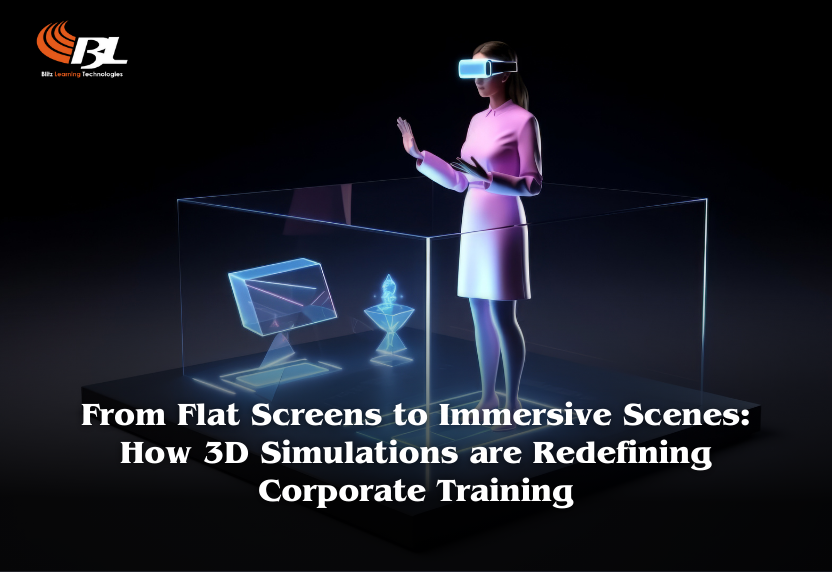
Blog
- Home
- Blog

22Jan
From Flat Screens to Immersive Scenes: How 3D Simulations are Redefining Corporate Training
Introduction
In today’s fast-paced corporate environment, traditional training methods often fall short of equipping employees with the skills they need to succeed. The advent of 3D simulations has revolutionized corporate training, transforming passive learning into an engaging and interactive experience. By blending immersive technology with real-world scenarios, 3D simulations are setting a new standard for skill development and employee engagement.
Bridging the Gap Between Theory and Practice
Corporate training programs often struggle to translate theoretical knowledge into practical skills. 3D simulations bridge this gap by creating realistic environments where employees can apply what they’ve learned in a risk-free setting. For example, a manufacturing trainee can operate a virtual assembly line to learn machine handling without jeopardizing safety or production. Similarly, sales professionals can navigate customer interactions in simulated scenarios, honing their negotiation and communication skills.
By mimicking real-life challenges, these simulations enable employees to practice, make mistakes, and learn without the fear of real-world consequences. This hands-on approach fosters deeper understanding and retention compared to traditional lecture-based training.
Enhancing Engagement and Retention
Engagement is a critical factor in the success of any training program. According to research, learners retain up to 75% of information through experiential learning compared to just 5% from passive listening. 3D simulations captivate learners by immersing them in dynamic, interactive scenarios. Whether it’s exploring a virtual oil rig or troubleshooting a technical issue in a simulated server room, these experiences keep employees actively involved.
Gamification elements, such as challenges, leaderboards, and rewards, further enhance engagement. Learners are motivated to complete tasks, achieve goals, and compete with peers, making the training process both enjoyable and effective.
Scalability and Customization
One of the standout advantages of 3D simulations is their scalability and customization. Companies can design training modules tailored to specific job roles, industries, or organizational needs. For instance, a healthcare organization can create simulations for surgical procedures, while a logistics company might focus on supply chain management scenarios. These modules can be scaled to train hundreds or even thousands of employees, ensuring consistency in learning outcomes across the organization.
Cost-Effectiveness and ROI
While the initial investment in developing 3D simulations might seem significant, the long-term benefits far outweigh the costs. Traditional training often involves expenses like travel, accommodation, and equipment, which can add up quickly. 3D simulations eliminate many of these costs by providing a virtual training environment that employees can access from anywhere.
Moreover, the improved effectiveness of training translates to better employee performance, reduced errors, and lower attrition rates, offering a substantial return on investment (ROI). Companies that adopt 3D simulations often report faster onboarding, increased productivity, and enhanced skill proficiency among their workforce.
Future-Ready Workforce
As industries evolve, the need for adaptable and tech-savvy employees becomes paramount. 3D simulations prepare the workforce for the future by familiarizing them with emerging technologies and complex systems. Employees trained through immersive simulations are better equipped to handle real-world challenges, ensuring that businesses remain competitive in an ever-changing landscape.
Overcoming Challenges
While 3D simulations offer numerous benefits, their adoption does come with challenges. Developing high-quality simulations requires expertise in instructional design, graphic modeling, and programming. Additionally, employees may initially resist adopting new training methods due to unfamiliarity with the technology. However, these hurdles can be mitigated through collaboration with experienced developers and providing adequate orientation sessions for learners.
Conclusion
From flat screens to immersive scenes, 3D simulations are redefining the way corporations train their employees. By offering realistic, engaging, and scalable solutions, they not only enhance learning outcomes but also drive organizational growth. As technology continues to advance, the role of 3D simulations in corporate training is set to expand, paving the way for a more skilled and future-ready workforce.
Investing in this cutting-edge approach is not just a trend but a strategic move that aligns with the demands of the modern workplace. The question isn’t whether to adopt 3D simulations, but how soon organizations can harness their transformative potential.

Neha Khare
About authorNeha Khare specializes in designing engaging and effective learning experiences tailored to learners' needs and also creates insightful blogs on corporate e-learning. She develops creative instructional methods, integrates multimedia, and aligns content with learning goals. Neha's innovative techniques and blog contributions significantly enhance the quality and impact of corporate training programs.



Leave a comments